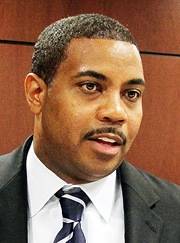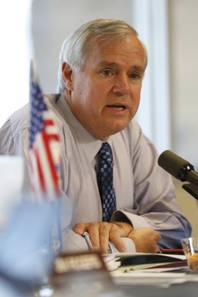Published Thursday, Aug. 16, 2012 | 2 a.m.
Updated Thursday, Aug. 16, 2012 | 9:25 a.m.

Senate Majority Leader Steven Horsford, D-North Las Vegas

Chancellor Dan Klaich
About the proposed new funding formula:
• Rewards institutions for graduating students, instead of enrolling students, by emphasizing “completions,” when students successfully finish a course.
• Would give special appropriations for small, rural colleges who would be at a disadvantage under the proposed new formula because of their low student enrollment.
• Would fund programs based on an institution’s mission. For example, research could be funded with state dollars at UNLV and UNR, but not at community colleges. On the other hand, research institutions would not get funding for remediation courses.
• Starting in 2015, institutions would be given bonus funding based on their performance, as measured by how well they execute their mission. This “performance pool” funding is still in the works, but by 2018 would be 20 percent of the $362 million in state funding allocated to higher education.
• Medical, law, dental and the Desert Research Institution would be excluded from the funding formula. They would be funded by the state separately from other institutions.
Policymakers turned to verbal sparring Wednesday as they worked to finalize the framework for a new higher education funding formula.
Tensions ran high as state Sen. Steven Horsford, D-North Las Vegas, grilled Nevada’s higher education Chancellor Dan Klaich over the specifics of his proposed new funding formula.
“I think this is tinkering, not fundamental reform,” Horsford said, describing Klaich’s proposal at one point during a heated debate. “This is why the public hates government. This is unacceptable.”
The Nevada System of Higher Education’s proposed funding model — introduced in January — seeks to create a more transparent, fair and easy-to-understand way to distribute state funding to Nevada’s seven public universities and colleges every two years. The chancellor’s proposed formula would allow institutions to keep their own student tuition and fee dollars, but be supplemented with about $362 million in state funding.
Lawmakers and higher education officials have debated for months in committees over how this state funding would be allocated among institutions of different types, sizes and missions.
Regardless of whether the institution is a major research university or a rural community college, state funding would be distributed via a “discipline matrix,” which assigns weights to each degree program based on how much it costs the state to run.
Resource-intensive degrees in science, engineering and the medical fields would be funded more than liberal arts programs. Masters and doctoral programs would receive more money than undergraduate programs.
However, institutions would only get funding for courses that have been successfully completed by students. “F” grades — including those given to students who drop out — will not be counted.
Although lawmakers and higher education officials seem to approve this overall “base funding” method, they have disagreed on how much to weight each course. Both groups hired consultants to study how other states determine this “cost per student credit hour.”
Klaich hired the National Center for Higher Education Management Systems, a nonprofit higher education group that looked at four states with funding formulas that Nevada could model: Florida, Illinois, Ohio and Texas. NCHEMS averaged the course weights from the four states over a period of time to determine a weighting system for Nevada.
The Nevada higher education system spent about $7,500 for the analysis. The funds were not taxpayer dollars, Klaich said.
The Legislature’s Committee to Study the Funding of Higher Education’s funding formula hired a different consultant, SRI International, a nonprofit research institute that looked at Nevada’s current funding formula and compared it with those in all 50 states. While SRI didn’t necessarily recommend a particular state’s funding formula, SRI’s senior economist Roland Stephen said the University of Texas system has a rigorous system to determine course costs annually.
The Legislature’s contract with SRI is $150,000, which is funded through a grant from the Bill and Melinda Gates Foundation.
Committee Chairman Horsford — who is running this fall for Congress — said he was concerned with Klaich’s proposed funding formula, which derives its course weighting system from NCHEMS.
“NCHEMS overvalues some degrees and undervalues others,” Horsford said, arguing that NCHEMS has not been transparent in its calculations. “I don’t think it works for Nevada.”
Klaich defended NCHEMS’ analysis, arguing the Boulder, Colo., group is a national leader in studies of higher education systems. Although he admitted he did not know its exact methodology, Klaich said the group looked at four state funding formulas over a period of time to come up with Nevada’s “discipline matrix.”
“They know more about higher education funding than any other entity in the country,” Klaich said. “I didn’t second-guess them.”
Horsford said he wasn’t satisfied with Klaich’s ansswer for using NCHEMS. The argument escalated.
“It doesn’t meet my smell test for transparency,” Horsford said, adding that Nevada should undertake its own cost analysis to determine course weights. “Texas’ (method) is more data-driven.”
“Very data-driven, but very state-specific,” Klaich countered. “We don’t have that money (to undertake a cost analysis). We don’t have any money to educate our students.”
“So we’re just supposed to rubber-stamp this?” Horsford asked. “I’m not comfortable just to apply (NCHEMS’ analysis) without looking into it. … As an elected official, I can’t defend this.”
Committee members eventually tabled the discussion, asking SRI to return to its Aug. 29 meeting with another analysis of the differences between Texas and NCHEMS’ weighting systems.
The committee has until late September to finalize its new funding proposal before the governor approves the Nevada higher education system’s budget request. Still to be determined is how the state will fund campus operation and maintenance and how to phase in the new formula.
After the meeting, Klaich said he wasn’t surprised by the “vigorous debate” over the funding formula. Regardless of the differences, both sides agree on the overall proposal — just not how to implement it, he added.
Horsford echoed Klaich’s sentiments.
“These are very important decisions and our discussions can get heated,” he said, adding he respects the chancellor. “We’ve had a formula that has not been equitable for all students in all regions. My motivation is to get this (new formula) right for our students.”

Join the Discussion:
Check this out for a full explanation of our conversion to the LiveFyre commenting system and instructions on how to sign up for an account.
Full comments policy